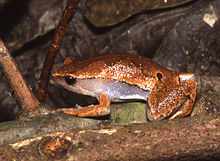Hamptophryne boliviana, also known as the Bolivian bleating frog[1][2] or Amazon sheep frog,[3] is a species of frogs in the family Microhylidae.[2][4] It is found in the northern and western sides of the Amazon basin in Bolivia, Brazil, Colombia, Ecuador, French Guiana, Guyana, Peru, Suriname, and Venezuela.[2][1] Genetic analysis suggests hidden diversity within the nominal species.[4][5]
| Hamptophryne boliviana | |
|---|---|

| |
| Scientific classification | |
| Domain: | Eukaryota |
| Kingdom: | Animalia |
| Phylum: | Chordata |
| Class: | Amphibia |
| Order: | Anura |
| Family: | Microhylidae |
| Genus: | Hamptophryne |
| Species: | H. boliviana
|
| Binomial name | |
| Hamptophryne boliviana (Parker, 1927)
| |
| Synonyms[2] | |
|
Chiasmocleis boliviana Parker, 1927 | |
Description edit
Adult males from Peru measure 34–39 mm (1.3–1.5 in) and adult females 39–44 mm (1.5–1.7 in) in snout–vent length;[6] some populations might be smaller in body size.[4] The body is moderately robust. The fingers and toes bear distinct terminal discs; lateral fringes and webbing are not present. The dorsum is tan with a large, brown mid-dorsal blotch. There is usually a faint, creamy white mid-dorsal stripe. The flanks, sides of the head, and concealed surfaces of the limbs are dark brown. Males have dark brown throat. The belly and ventral surfaces of the hind limbs are creamy white with brown spots or reticulations. The iris is pale bronze and has fine black reticulations.[6]
Habitat and conservation edit
These frogs are found in the leaf litter of primary and secondary tropical rainforests at elevations up to 400 m (1,300 ft) above sea level.[1] They are nocturnal and feed on ants on the ground or on tree trunks and branches.[6] Breeding takes place in ponds and flooded areas within forest after heavy rains.[1][6]
This species is widespread but uncommon in much of its range. No significant threats affecting this species have been identified.[1]
Behavior edit
The frog has been spotted in close association with Xenesthis immanis, the Colombian lesser black tarantula. It is possible that they have a mutualistic relationship in which the spider may protect the frog and its eggs from predators while the frog protects the spider's eggs from ants, as observed between frog Chiasmocleis ventrimaculata and the same species of tarantula.[7]
References edit
- ^ a b c d e f Enrique La Marca, Robert Reynolds, Claudia Azevedo-Ramos, Luis A. Coloma, Santiago Ron (2004). "Hamptophryne boliviana". IUCN Red List of Threatened Species. 2004: e.T57821A11688802. doi:10.2305/IUCN.UK.2004.RLTS.T57821A11688802.en. Retrieved 16 November 2021.
{{cite journal}}: CS1 maint: multiple names: authors list (link) - ^ a b c d Frost, Darrel R. (2017). "Hamptophryne boliviana (Parker, 1927)". Amphibian Species of the World: an Online Reference. Version 6.0. American Museum of Natural History. Retrieved 19 October 2017.
- ^ "Amazon Sheep Frog (Hamptophryne boliviana)". iNaturalist. Retrieved 19 October 2017.
- ^ a b c Ortiz, D.A.; et al. (2013). "Hamptophryne boliviana". Ron, S. R., Guayasamin, J. M., Yanez-Muñoz, M. H., Merino-Viteri, A., Ortiz, D. A. and Nicolalde, D. A. 2016. AmphibiaWebEcuador. Version 2016.0. Museo de Zoología, Pontificia Universidad Católica del Ecuador (QCAZ). Retrieved 20 October 2017.
- ^ Fouquet, Antoine; Gilles, André; Vences, Miguel; Marty, Christian; Blanc, Michel; Gemmell, Neil J. & Volff, Jean-Nicolas (2007). "Underestimation of species richness in Neotropical frogs revealed by mtDNA analyses". PLOS ONE. 2 (10): e1109. CiteSeerX 10.1.1.283.6960. doi:10.1371/journal.pone.0001109. PMC 2040503. PMID 17971872.
- ^ a b c d Rodríguez, Lily O. & Duellman, William E. (1994). "Guide to the frogs of the Iquitos Region, Amazonian Perú". Special Publication, Natural History Museum, University of Kansas. 22. Asociación de Ecología y Conservación, Amazon Center for Environmental Education and Research and Natural History Museum, University of Kansas: 1–80.
- ^ Naish, Darren. "Tiny Frogs and Giant Spiders: Best of Friends". Scientific American Blog Network. Retrieved 2020-05-02.
